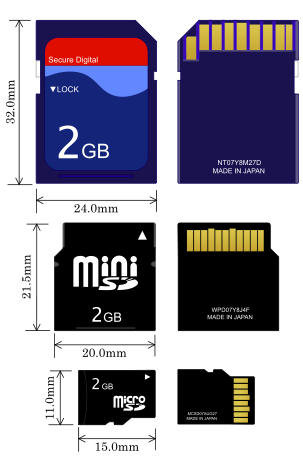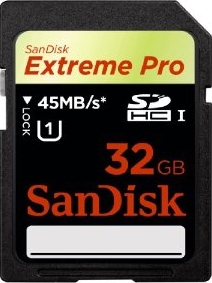SD (Secure Digital) Memory Card Basics
By Stephen Bucaro
(SD) Secure Digital is a solid state memory card technology developed for use
in digital cameras, video recorders, and other portable devices. The first SD cards
came in 2 GB and 4 GB capacity. Later SDHC (High-Capacity) cards were developed
with a capacity of 4 GB to 32 GB. Today, SDXC (eXtended-Capacity) cards come with
a capacity of up to 2 TB.
The availability of 4 GB capacity in both the SD and SDHC technologies has
caused some confusion with users. If you have a SDHC device, you can use your old
SD memory card in that device. The SDHC standard is backwards compatible with SD
technology. However, you cannot use an SDHC memory card in an old SD device,
unless you can update the drivers.
Similarly, you can use your old SDHC memory card in a SDXC device (you can even
use an SD memory card in a SDXC device). But you cannot use an SDXC memory card
in an old SDHC device, unless you can update the drivers.

SD memory card also come in several different sizes: full size, mini, and micro.
They make adapters allow the physical conversion of smaller SD cards to work in a
larger physical slot, these are passive devices that connect the pins from the
smaller SD card to the pins of the larger SD adapter. Since cards from the different
technologies can have the same physical size, it causes confusion with users.
For example, microSD, microSDHC, and microSDXC are all the same physical size,
but the capabilities for each is defined by its respective technology.
The full size SD cards may have a write-protection notch. If the notch is
covered by sliding the write protection tab, then the card is writable. Not all
full size SD cards have a write-protection notch, and there is no write-protection
notch on the microSD and miniSD sizes.
SD cards ship preformatted with a file system. Standard SD cards are typically
formatted as FAT16, SDHC cards as FAT32, and SDXC cards as exFAT (FAT64). SD
devices can become fragmented, and because they contain a standard file system,
they can be defragmented, but this would be a waste of time because fragmentation
does not down the speed of a solid state device. But because of the type of solid
state device used (EEPROM), too much defragmentation will wear out the card, as
the number of writes, before failure occurs, is limited (sometimes to as few as
100,000 times).

SanDisk 32GB SDHC UHS I

A specific SD card may support various combinations of bus types and transfer
modes. 2 MB/s is the slowest transfer rate for SDHC cards. Old standard SD cards
would have a slower transfer rate. Newer SDHC and SDXC cards may have a UHS-I
(Ultra High Speed) mode supporting data transfer speeds up to 104 MB/s, or a
UHS-II mode supporting transfer rates up to 312 MB/s. These memory cards will
be marked with UHS-I or UHS-II to indicate their performance.
SD cards come in a variety of sizes, storage capacities, and transfer speeds.
This makes it confusing for users to choose the correct memory card for their
products. This article touches on the SD technologies available at the time of
writing, and new technologies are coming out every day. To get the correct memory
card you'll need to check the product's manual.
If your computer has a built-in SD slot, your operating system may not support
the latest SD memory cards unless you can update the drivers. They also make SD
to USB adapters that allow you use your SD card through a USB port.
More Computer Anatomy Articles:
• The Small Computer System Interface (SCSI)
• Tips and Techniques For Building Your Own PC
• Hardware Resources Explained
• Building Your Own PC! - The Motherboard is the Core of the PC
• History of the QWERTY Keyboard
• How a laser Printer Works
• Basic Computer Thermodynamics
• The Master Boot Record (MBR)
• How is Data Written, Stored On, and Erased From Hard Disks?
• What is Bluetooth?
| 
